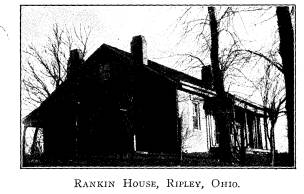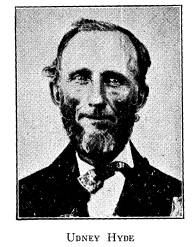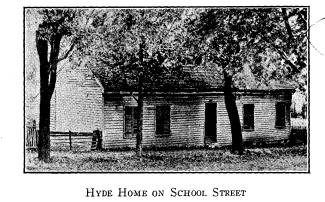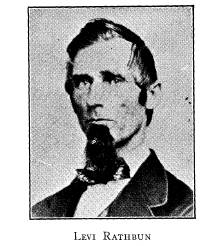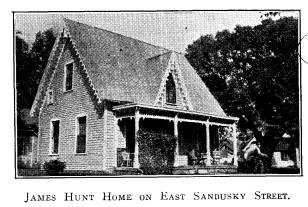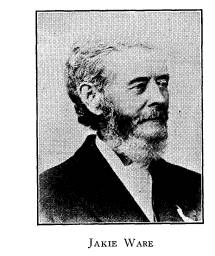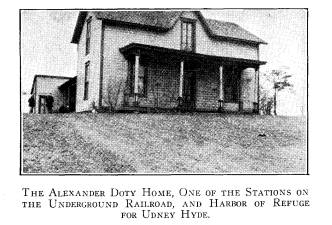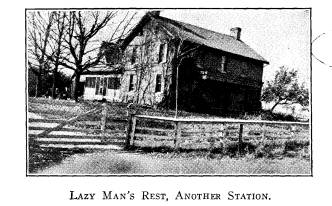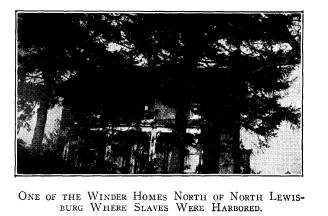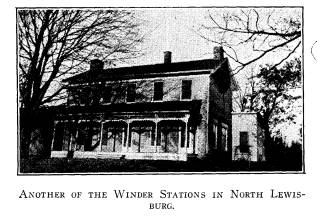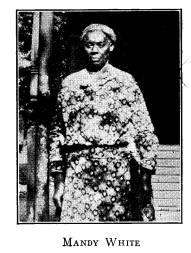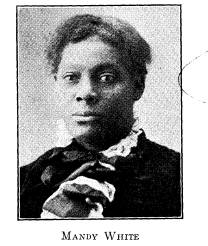Ohio History Journal
HISTORY OF THE UNDERGROUND RAILROAD
IN MECHANICSBURG
BY RALPH M. WATTS
"Champion of those who groan
beneath
Oppression's iron hand:
In view of penury, hate and death,
I see thee fearless stand,
Still bearing up thy lofty brow,
In the steadfast strength of truth,
In manhood sealing well the vow
And promise of thy youth.
Go on, for thou hast chosen well;
On in the strength of God;
Long as one human heart shall swell
Beneath the tyrant's rod,
Speak in a suffering nation's ear,
As thou hast ever spoken,
Until the dead in sin shall hear,
The fetter's link be broken!"
Tribute to William Lloyd Garrison
--John Greenleaf Whittier.
One who has sojourned in the quiet
little village of
Mechanicsburg can hardly realize that
at one time in the
past it was the scene of stirring
events that at times
took on the semblance of a real
tragedy--a drama that
began as early as 1851 and did not
reach its climax until
1857--a climax of such importance that
it did as much
to create abolition spirit in Ohio as
any other event, not
even excepting the Dred Scott Decision.
During the
greater part of this period the friends
of slavery dubbed
Mechanicsburg a "black abolition
hole." In and around
Mechanicsburg there was a little group
of men who
Vol. XLIII-14 (209)
210
Ohio Arch. and Hist. Society Publications
were as ardent abolitionists as could
be found any-
where.
The development of this abolitionist
sentiment
seemed to be sporadic and not due to
influences of re-
ligious sects, as was the case in other
communities. In
fact, the outstanding figure in the
local drama could
hardly be classed as a religious
devotee.
The knowledge that this abolition
spirit existed in
Mechanicsburg led those who were active
in assisting
escaped slaves at other points to seek
connections in this
vicinity, which action eventually led
to this town being
established as one of the most noted
stations on the
Underground Railroad. Three distinct
routes passed
through Mechanicsburg, and these, in
turn, had switch-
ing connections with several other
routes. In addition
to this, the Mechanicsburg stations
became so well
known that many escaped slaves who were
not under
regular convoy filtered in here from
the South. The
fact that Mechanicsburg was outstanding
as an aboli-
tionist center was emphasized by the
fact that it was
surrounded by territories which were
unfriendly to the
anti-slavery movement. This factor made
the task of
transporting slaves more hazardous, and
as a conse-
quence, greater skill was required to
escape detection.
One is surprised at the difficulty he
meets in gaining in-
formation about the Underground
Railroad, until he
realizes that the activities were
carried on so secretly
that even friends of the movement knew
of the details
of only the particular activities in
which they assisted.
Prior to the establishment of
Mechanicsburg con-
nections, most of the slaves who were
able to get as
far north as South Charleston were
carried by means
History of the Underground
Railroad 211
of the well-known routes in the
vicinity of Springfield
and Urbana. Eventually these routes
became so well
known and so carefully watched that it
seemed expedient
to bring some slaves through
Mechanicsburg.
Most of those who absconded from their
masters in
Kentucky and the other slave states and
chose the routes
passing through Mechanicsburg, came
across the Ohio
River at Ripley, Ohio. The most
conspicuous figure in
this division terminus of the
Underground Railroad was
Rev. John Rankin, a Presbyterian
minister. This man
owned a home situated on a hill above
the little town of
Ripley, and from this vantage-point a
lantern placed
within an open window in the attic of
the house flashed
its freedom signal to guide the poor
ignorant negro
across to Ohio to safety.1 Today,
this station attracts
tourists from all parts of the United
States; for tradi-
tion says that it was in a room in this
house that Harriet
Beecher Stowe penned the initial lines
of her immortal
book, Uncle Tom's Cabin. Mr.
Rankin could boast that
none of the slaves whom he escorted
along the Under-
ground Railroad were ever captured. At
this point the
Underground Railroad had its inception,
as a haphazard
and accidental agency, which later on
developed into a
well-organized and deliberate
institution.
The slaves went from the station in
Ripley to Wil-
liam Miners' station, six miles north
of Ripley towards
Hillsboro; from here to a station in
the vicinity of Rus-
sellville, conducted by a man whose
name was Patton.
Two distinct routes emanated from
Ripley: one was
1 Letter from Richard Rankin.
Other histories of Ohio seem to verify
this.
|
212 Ohio Arch. and Hist. Society Publications through Hillsboro, Wilmington, and Xenia; the other through Washington Court House and London.2 The year 1851 is epochal in the story of the Under- ground Railroad in Mechanicsburg; for it was then that Udney Hyde actively assumed the task of personally guiding and assisting slaves to escape to Canada. Mr. Hyde often said that while he had heard much of the logic of the slavery controversy, it was while watching |
|
|
|
lambs at play that he was converted to abolitionist sym- pathies. He noticed that when he separated the young lambs from their mothers, the black sheep mourned for their lambs just as much as the white mothers mourned the loss of their offspring. This was enough of an analogy to convince Mr. Hyde that by aiding the slaves to escape he would be "breaking the laws of man but keeping the laws of God." Acting accordingly he con- sented to aid in the transportation of slaves.3 The first load carried through by Mr. Hyde con- sisted of seven darkies, four of whom had been delivered 2 Letter from Richard Rankin. 3 Mrs. Kent, conversation. |
|
History of the Underground Railroad 213 to him by Jacob Pearce from South Charleston.4 The other three members of the human cargo had been brought from Urbana. The seven stayed all night at the Hyde cabin. Then bright and early on the morning of September 20, 1851, Mr. Hyde hitched up his wagon, loaded in the negroes, covered them with hay to serve as camouflage, and made his initial "run" on this new branch railroad, which was to consume so much of his later time and energy.5 |
|
|
|
To at least two members of the party of four the success or failure of this trip meant practically life or death. Penny, a free negro living at Ripley, Ohio, had become infatuated with a slave-girl belonging to a Bap- tist preacher in Kentucky. Many times had Penny pleaded with his sweetheart's master to sell her to him; but the master was not willing to price her. After many 4 Mrs. Kent, conversation. 5 Conversation with Mrs. Kent, Marysville Tribune, September 15, 1897. |
214
Ohio Arch. and Hist. Society Publications
vain attempts, however, Penny bargained
for her free-
dom in exchange for his services to the
master for one
year. The year's labor having been duly
completed,
Penny asked for his reward, but the
master in anger
threw him forty dollars and ordered him
to "clear out.'
Penny picked up the forty dollars and
walked away; but
his absence was not to be purchased at
such a low price,
for he used the money to purchase firearms.
When
Saturday night arrived, Penny went to
the master's
home, and taking his sweetheart, her
sister, her sister's
husband and another man, attempted
escape. In the
front yard of their master's home, they
knelt and vowed
that they would reach freedom or die in
the attempt.
Too, they drew up a verbal compact that
they would
not be taken alive and that the first
one to lose his cour-
age and suggest turning back should be
shot by the
other members of the little band.
However, the little
party had scarcely reached the banks of
the Ohio when
they were accosted by two men sent out
by the master
to capture them. Penny brought his new
firearm into
play at this juncture by shooting one
of the pursuers,
wounding him seriously. Shots were
generously ex-
changed with the result that one of the
negroes was in-
jured also, but nevertheless, they
succeeded in crossing
the river. Leaving their wounded
comrade with friends
at Ripley, Ohio, the others continued
their journey to
South Charleston and Mechanicsburg
where they were
enrolled on Mr. Hyde's first passenger
list.
We have innumerable incidents in the
history of Mr.
Hyde's activities, founded on
substantial facts but which,
nevertheless, make it read like a
novel. One day, for
example, he started to Ripley, saying
that he was going
History of the Underground
Railroad 215
to the river to get a load of castings
to be used in his
blacksmith shop. Among the slaves which
he hauled
back on this particular trip was an
octoroon. Having
brought her safely to Mechanicsburg, he
now faced the
task of getting her to her next
destination. And we
must remember that besides antagonistic
sentiment of
local pro-slavery men, the presence of
federal marshals
in the community made the task of the
"conductor" a
real game of wits. In order to escape
suspicion, Mr.
Hyde dressed this girl in some of his
wife's clothing,
including a bonnet with a face veil.
Then mounting
her on a horse, he started with her in
the general direc-
tion of Delaware.
Everything went well until they
approached Belle
Point, where the pair was followed by
some men on
horseback. Looking back, the girl
exclaimed, "My God,
here comes my master!" Then Mr.
Hyde's nerve and
head served him well. He instructed her
to keep jerking
on the right rein to make the horse
prance so as to keep
the girl's back nearest to the
approaching riders and
thus hide her identity. Half under his
breath, he
warned, "No matter what happens,
what I shout, or
how I swear at you, pay no attention,
but keep saunter-
ing on down the road."
In the meantime the horsemen were
fairly up to Mr.
Hyde who was now calling to his
"wife," "Keep your
head: she won't hurt you." By this
time, the slave-girl
had gone around the bend in the road,
and when out of
sight of her pursuers, rode as fast as
possible to a
Quaker preacher's home in the clearing
in the woods.
Hyde then rode up and began conversing
with the min-
ister's wife. When the officers rode up
as if in pursuit,
216
Ohio Arch. and Hist. Society Publications
Udley told them in no mincing language,
"Now if you
fellows ever follow me and my wife
again, I'll shoot
you."6 In the meantime,
the negress had found shelter
until the officers had passed.
Now this Quaker preacher had a novel
way of con-
ducting his "depot."7 He
had previously built a new
home to replace his old log cabin.
Under the cover of
night, he dug a basement under this old
abandoned cabin
and then threw the dirt into an old
well to escape sus-
picion. The entrance to this basement
he covered with
wheat so that when anyone approached
whose mission
was unwonted, some of the family would
be busily en-
gaged in flailing grain.8 In
this basement the girl re-
mained for two days, until she could be
taken to another
Quaker settlement (probably Alum
Creek).9
Many times it seemed that the clutches
of the law
were closing in on Mr. Hyde's
activities. Once a negro
came hurriedly to Mr. Hyde's home and
asked for
shelter, for the slave-catchers were
hot on his trail. To
the ordinary individual, this situation
would have been
too dangerous a one on which to
intrude, but the ex-
perienced Udney Hyde at once took
charge of the
fugitive. Hurriedly hitching his team
to his wagon,
with a false-bottomed rack which
provided concealment
for the negro, he started toward
Ripley, backtracking
over the same trail the negro had
followed only an hour
or so before. The colored man was kept
well concealed
on the bottom of the wagon while Mr.
Hyde continued
his journey toward the Ohio River. They
had been
6 "Tod Owens," who worked for
Mr. Hyde.
7 Mrs. Kent.
8 Mrs. Kent.
9 Not certain.
History of the Underground
Railroad 217
driving some time when far in the
distance there ap-
peared a cloud of dust from which a
small speck emerged
and developed into the grim outline of
a spring wagon.
Mr. Hyde then turned to the slave and
said, "Here
comes a slave-holder whom I know, and
I'll have to
talk to him."10 The two
wagons drew alongside and a
conversation began. The slaveholder,
seeing Mr. Hyde
was headed toward the Ohio River
instead of away from
it, casually inquired, "Hyde, why
aren't you helpin'
niggers ?"
"Well, if I knew of any needin'
help, I would be
helpin' 'em," was Hyde's casual
reply. Then each of
the vehicles continued on its way. Hyde
went several
miles farther, then turned back toward
his home by
means of a circuitous course. That
night he concealed
the slave in the cellar of his home.
But his troubles
did not end then; for that very evening
a marshal and
a slaveholder came and stayed all night
at the Hyde
home. Fortunately the slaveholder and
the marshal
never suspected that they were not the
only "guests."11
Another time Mr. Hyde had a load of
negroes in his
wagon and was met by some slaveholders.
When asked
what he had under the hay in his wagon,
Mr. Hyde
laconically replied, "Niggers,
G--d--you!" The slave-
holders, believing Mr. Hyde was merely
trying to get
them to examine an empty wagon, allowed
him to drive
on without any further interruption.12
On at least one other occasion, Mr.
Hyde narrowly
escaped detection by the law. This time
he was coming
10 Mrs. Kent.
11 Mrs. Kent.
12 William Todd and Mrs. Kent.
218
Ohio Arch. and Hist. Society Publications
along by the McConkey schoolhouse,
southeast of
Catawba, headed toward Mechanicsburg
with some
slaves covered by hay when his wagon
got stuck in the
mud. While attempting to extricate his
vehicle, Mr.
Hyde was approached by some marshals.
They wanted
to help him, but he refused to unload
his wagon as he
was advised to do by these men, saying,
"I'll kill the
damned horses first!" His bold
affrontery again served
him in good stead in eluding the
slave-catchers, for he
was able to get the wagon out of the
mud without re-
vealing the contents of his cargo.
It is sometimes true that the persons
for whom we
do the greatest favors turn out to be
our most ungrate-
ful friends. But Leo L. Lloyd, a
colored slave whom
Mr. Hyde aided to escape by dressing
him in girl's cloth-
ing and transporting him on horseback,
returned several
years later to see Mr. Hyde.13 When
he came into the
room, Mr. Hyde recognizing him,
immediately asked:
"What are you doin' here,
nigger?"14
"Mr. Hyde, I have gone to school
'til I'm pretty
well versed in education and have a
good job and some
money. I've always wanted to repay you
for saving
me, so I came back to give this to you
as a token of
appreciation."15 The
negro then opened a package which
contained a cane with an ebony head. It
is said that
Lloyd had purchased this cane in Africa
while on a trip
there to see his parents, several years
after the war.16
Such was the appreciation of this negro
for Mr.
Hyde's kindness.
13 Mrs. Kent.
14 Tod
Owens, who was staying with Mr. Hyde at the time.
15 Mrs. Kent has the cane, in her
possession to-day.
16 Mrs. Kent.
|
History of the Underground Railroad 219 Mr. Hyde kept an account of the number of slaves carried through, and the total reached the astounding figure of five hundred and seventeen,17 of which none was ever recaptured. The largest number ever carried in one load by Mr. Hyde consisted of eleven men, eleven women, and two children. When Mr. Hyde moved into Mechanicsburg, he continued his activities in a small frame house on School Street, in which he concealed the negroes in a cellar, |
|
|
|
access to which was obtained through a trap door in the bedroom.19 It is said that it was not unusual to see three or four negroes in the cellar at one time. Here, it is alleged, was born the first colored child in the town of Mechanicsburg.20 This child was born to a slave- girl who was being transported to Canada. All of the ladies living in the vicinity who knew of the occurrence, went to get their first view of a colored baby. The Hyde home has been torn down, but probably 17 Mrs. Kent and others. 19 William Todd and others. 20 William Todd and others. |
|
220 Ohio Arch. and Hist. Society Publications if the truth were known, many a "lad" who is now a gray-haired man can recall how his ankles willingly an- swered the persistent impulse to run past this house. In addition to this place on School Street and the cabin which was the scene of his early activities, Mr. Hyde hid slaves in the old Joiner livery stable,21 which was located near the square in Mechanicsburg, and in a well near his own livery barn on School Street. He |
|
|
|
had a platform placed in the well, which was an excava- tion some six or seven feet in diameter,22 on which the negroes could stand during the day, waiting to be sent farther on their trip to Canada when darkness came. The Hyde stations were not the only stations within the limits of the little village. The one that will prob- ably be of the greatest interest to the present generation is the house that was owned and operated as a terminal 21 Tod Owens (site now occupied by the home of Dr. Ogden). 22 Mrs. James Magruder. |
|
History of the Underground Railroad 221 by Levi Rathbun,23 which is now the James Hunt home on East Sandusky Street. This house, the upper story of which is a veritable maze of small rooms and closets tucked snugly into suspicious-looking compartments pro- tected by hip-roofs, and accessible only by means of small, inconspicuous doors, stands as a landmark in the history of our little town. It stands as a mute reminder to the present generation of the struggles of men whose convictions were so strong that time and money could |
|
|
|
not defeat them in their struggle to rid their country of a shameful institution--a monument commemorating one of the most vivid and dramatic chapters in the thrill- ing story of the adventures of the agents of the Under- ground Railroad. Mr. V. S. Magruder used to relate an incident that transpired at this Rathbun dwelling. The Magruder home was situated across from the Rathbun residence (where the Emaline McCrocklin home is located today). Young "Sale," a mere lad then, was quite frequently 23 William Todd, also Mrs. Florence Wing. |
|
222 Ohio Arch. and Hist. Society Publications sent by his mother to take food across the street to the Rathbun home. Naturally little "Sale's" mind be- came quite perplexed at this situation. He reasoned that his parents were not as much blessed financially as the neighbors across the way; yet here his parents were seemingly being forced to help this Rathbun family. At last, Mrs. Rathbun, having secured a solemn promise of |
|
|
|
secrecy from the boy, eased his curiosity by showing him the contents of the cellar. Imagine his surprise when he saw, not potatoes, cabbages, and the usual con- tents of a cellar--but negroes!24 On the present site of the Methodist Protestant par- sonage there stood a house in the basement of which "Jakie" Ware stored slaves.25 He had his basement so 24 Written documents left by James Magruder. Conversation with William Magruder. 25 William Saxbe, conversation; also Mrs. Foster. |
History of the Underground
Railroad 223
arranged with crevices, hidden rooms
and dungeons that
it was often referred to as the
"Catacombs."26
Mr. Ware, too, was an ardent
abolitionist who not
only sympathized with the negro, but
actively engaged
himself in transporting the slaves. Mr.
Ware became
an abolitionist during a trip which he
made into the
South where he saw a slave girl sold on
the auction
block, the sight of which, he often
said, "made his very
blood boil."27 Mr.
Ware's anti-slavery activities in-
curred such enmity among some of his
fellow-members
of the M. E. Church that they refused
to go to the
communion table with him.28
Mr. Ware used the same method for
eluding detec-
tion as Mr. Hyde--that of concealing
his clandestine
passengers under some hay in his wagon.
But one ruse
employed by Mr. Ware is certainly
deserving of com-
ment. At one time when he wished to
transport a large
load of slaves, and feared the
ever-threatening menace
of Southern sympathizers, he allowed
his daughter, Mrs.
Anna Sabine, to drive the wagon. True
to Mr. Ware's
fortunate forethought, the seeming
innocence of the
young girl averted suspicion.
But to one man, working for the
Underground Rail-
road in Mechanicsburg almost proved a
disastrous avo-
cation. Mr. Levi Coffin made a practice
of hiding his
colored refugees in the David Rutan
place (now the
Clinton Hunter residence).29 Most of
these slaves he
brought to Mechanicsburg from
Springfield, Ohio. But
government agents obtained authentic
evidence of his
26 Mrs. Foster.
27 Mrs. Foster.
28 Mrs. Foster and others.
29 Tod Owens, conversation.
|
224 Ohio Arch. and Hist. Society Publications participation in negro smuggling and he was given the alternative of joining the army or going to the peni- tentiary. Naturally, Mr. Coffin's abhorrence of penal institutions influenced him to choose a sojourn in the army in preference to incarceration.30 Just as there were many incoming routes for slaves entering Mechanicsburg, likewise there were numerous branch railroads wending their way toward Canada. Toward the northeast there were several stations. One |
|
|
|
was at Five Points, between Mechanicsburg and Wood- stock, operated by Alexander Doty (later used by Udney Hyde as a hideout when he was being hunted by U. S. officers). The chief conductor to this terminal was Udney Hyde. Still another station in the same general direction was the one operated by Pearl Howard on the farm known today as "Lazy Man's Rest." The slaves were brought from the Ware farm to "Lazy Man's Rest," 30 William Saxbe, conversation. |
|
History of the Underground Railroad 225 where they were kept in a false-walled vault in the cellar, which was hidden back under the house at the end of a long passage.31 From the Pearl Howard farm, most of the slaves found passage to a station north of North Lewisburg on the John R. Wilson farm.32 Another haven of refuge for slaves passing through Mechanicsburg to the northeast was in Woodstock. In and near this little village, there were several stations. |
|
|
|
One was operated by Erastus Martin;33 another, by Ephraim Cranston, who lived between North Lewisburg and Woodstock on the farm now owned by Ott How- ard.34 Still another station contributing its bit to the abolishionist fame of Woodstock was that operated by "Johnnie" MacDonald, who resided where Gould Old- field now lives.35 31 Details related by the owner of this farm, Henry Ellsworth. 32 Mr. Wilson in Woodstock; Mr. Green in North Lewisburg. 33 Conversation with True Martin and others. 34 Charles Cushman, an old Civil War veteran. 35 Charles Cushman, conversation. Vol. XLIII--15 |
|
226 Ohio Arch, and Hist. Society Publications Just about a mile north of North Lewisburg there were several brothers known as the "Winder boys" who became famous as "operators."36 Thomas, one of the Winder brothers, owned a large farm on which stood a fine brick house in which he sheltered slaves.37 The second brother, Edward,38 owned and operated a station on a large farm adjoining that of Thomas Winder.39 Joshua Winder,40 neighbor of his brothers, also aided in harboring slaves. |
|
|
|
Edward Young, son-in-law41 of Thomas Winder, also helped in the anti-slavery movement. He lived in a home in the west part of North Lewisburg.42 Two other Winder boys, Abner and Aaron, also took part. From their stations, the Winder brothers took the slaves 36 Albert Green, colored ex-slave in North Lewisburg. 37 This same house is standing. 38 Albert Green. 39 This house has been remodeled. 40 Albert Green. 41 Albert Green. 42 Where Mrs. Townshend now resides. |
|
History of the Underground Railroad 227 to Alum Creek, fifteen miles northeast of Delaware, Ohio.43 The same locality was along the line of the southernmost route from Mechanicsburg.44 Udney Hyde, however, conveyed most of his slaves directly to Alum Creek,45 and was sometimes aided along this route by Charles P. Morse, then living between Marysville and the neighboring T. & O. C. and Big Four crossing. From his home Mr. Morse usually took his |
|
|
|
cargo immediately to Delaware, Ohio. Whenever pos- sible to make arrangements for carrying the slaves east- ward, Mr. Morse always did so; but in the event that he could not make arrangements for such immediate action, the slaves were hidden in an old loft in a barn back of his house.46 Another venerable benefactor of the dark-skinned race connected with this southern branch of the Under- 43 Albert Green. 44 Mrs. Kent and others. 45 Mrs. Kent. 46 Mrs. J. S. VanNess. |
228
Ohio Arch. and Hist. Society Publications
ground Railroad was William Cratty,
whose picturesque
activities merit comment. This man
began his partici-
pation in helping the negro as early as
1836, and con-
tinued it until 1853.47 Only for a
short time did he allow
other interests to divert his attention
from the slave
rescue work, and this interim occurred
when Mr. Cratty
joined the overland pilgrimage to
California in the Gold
Rush of '49.
In 1836, Mr. Cratty bought a farm in
Delaware
County which became one of the
historical landmarks as
a "station." Mr. Cratty's
activities were so extensive
that he incurred the public enmity of
slave-owners in
the slave states, who soon offered
$3,000.00 to any per-
son who should deliver his body, alive
or dead, south
of the Mason-Dixon line. In his later
days, Mr. Cratty
looked back with pride on his early
activities and fre-
quently commented that he had helped
three thousand
slaves48 to escape. In fact,
because his reputation be-
came so widespread, and because the
rumor was cir-
culated that there was a price on his
head, Mr. Cratty
was compelled to such a degree of
precaution that he
never opened the door of his home at
night without first
investigating the object of his
caller's visit. He was
constantly in fear that some avenging
slave-holder
would call at his home for the purpose
of taking his life.
Regardless of this constant threat, Mr.
Cratty was
bold in his talk and his actions
against the slavery in-
stitution. On the reception of the news
of the Fugitive
Slave Law of 1850--a law
which placed "aider and
47 All materials concerning William
Cratty are from written records
now in possession of Mary Wanzer
Furnish, Newport, Kentucky.
48 According to the records left by Mr.
Cratty.
History of the Underground
Railroad 229
abettor" under liability to the
master of the fugitive to
the extent of the slave's value--Mr.
Cratty publicly
announced that "Congress could not
pass an act that
could fetter his conscience; and that
he would continue
to run slaves, and that all men in
Congress and out of
it were welcome to the knowledge of his
intentions."49
One incident in the numerous
experiences of Mr.
Cratty's participation was frequently
re-told in the au-
tumn of his life because of the
forcible impression that
it had made upon him. It was the
discovery among his
cargo of a negro who had been fastened
in an iron col-
lar. He related that this device was
sometimes em-
ployed by the more barbaric masters to
prevent slaves
from successfully evading their
overseers by hiding in
the thickets and underbrush.
This contrivance, according to Mr.
Cratty, was an
iron collar riveted about the neck.
Iron hoops were
fastened to this in such a way that it
formed a loop
above the head; and from this loop was
suspended a
bell, which was outside of the range of
the grasp of the
slave. It seems that this particular
slave had worn this
device so long that his skin beneath it
resembled leather
rather than human skin.
This incident probably did more to whet
Mr. Cratty's
determination to free the negro race
than any other
event. And due to his personal
persistence and geo-
graphical location, Mr. Cratty must
have been a big
factor in the "board of
directors" of the Underground
Railroad. Mr. Udney Hyde made frequent
trips to
Mrs. Cratty's farm, where he delivered
slaves; so we
see that Mr. Cratty's home, the next
station on the trip
49 Records in the possession of Mrs.
Furnish.
230
Ohio Arch. and Hist, Society Publications
to Canada, was quite an outlet for our own branch of
the Underground Railroad.
From William Cratty's station, a good
many slaves
probably were delivered into the hands
of the Benedict
family, who resided about fifteen miles
northeast of
Delaware, Ohio. The Crattys and the
Benedicts were
friends, and according to traditions in
the Cratty fam-
ily, some of the slaves went from the
Cratty station to
the Benedict stations.
Aaron Benedict, like William Cratty,
had a price
placed on his head by the Kentucky
slave owners; in
his case, however, the price was
$1,000. The fact that
Aaron Benedict had been ringleader in a
rescue case in
Marion, Ohio, probably brought him the
publicity that
led to a price being offered for his
body.
A colored man had run away from the
Kanawha
Salt Works, West Virginia, and had
found his way to
Marion, Ohio, where he was employed as
a hostler in
a hotel. He had not been employed long,
however, un-
til his whereabouts were learned by his
former master,
who had him arrested and placed in
jail.
Having heard of the arrest, Mr.
Benedict drove to
Marion, went to interview the
incarcerated negro and
hoped to arrange for a lawyer to aid
the prisoner; but
upon hearing the man's story, Mr.
Cratty decided that
strategy would be more suitable than
diplomacy.
On the day of the trial, Mr. Benedict
and his col-
leagues had two speedy horses hitched
at a certain
place near the court house. According
to the plan, as
soon as the judge rendered his
decision--which Mr.
Benedict thought must certainly be
conviction--the
negro was to dash out of the court-room
and down the
History of the Underground
Railroad 231
stairs. Benedict and his men were to
protect the negro's
retreat by force. The negro was to flee
to an old
swamp, where he would later be joined
by his benefac-
tors.
When the trial began, however,
circumstances were
materially changed. The negro's former
owner had
been John Smith; and the judge in
giving his decision
ruled that inasmuch as all of the
witnesses had sworn
that this negro belonged to "Mr.
Smith," and that "Mr.
Smith" and "John Smith"
might be two distinct per-
sons, therefore he was deciding in
favor of the prisoner.
This ridiculous decision showed that
Northern judges
as well as Southern judges could be
biased in their de-
cisions in slave cases. Upon hearing
this decision, the
sheriff turned to the prisoner and told
him that he was
free. But as the negro arose to leave,
Mr. John Smith
took hold of the slave's arm and said,
"You belong to
me!" The sheriff then demanded
that Smith release his
victim; but Mr. Smith drew his
bowie-knife and shouted
"He'd have his nigger if he had to
go to hell or Canada
after him."50
In the fight that followed and became
more furious
as the group passed down the steps of
the court-house,
all sorts of weapons--fists, chair
rounds, and clubs--
were freely used by both sides. A
maelstrom of boister-
ous pulling, laughing, and tearing of
clothes developed.
The fighting continued into the street,
when suddenly
someone hit Mr. Smith over the head
with a rock. This
so infuriated him that he drew his
pistol, and placing the
muzzle against Mr. Benedict's breast,
pulled the trigger.
Aaron Benedict saw the contraction of
Mr. Smith's
50 From a written account left by Aaron
Benedict.
232 Ohio Arch. and Hist. Society Publications
hand, the blow of the hammer as it
fell, and the smoke
of the cap. All seemed to be over, and
he was helpless
to avert the impending disaster--but
the charge did not
explode. The fight was finally quelled
by the sheriff,
but not until Mr. Benedict had
succeeded in rescuing
the slave.
Taking a round about way, Mr. Benedict
and the
negro made their way to the swamp
previously agreed
upon. Here they stayed until about nine
o'clock that
night, when they were joined by Martin
Benedict. To-
gether, the two brothers took their
charge to the home
of their father, Reuben Benedict. Until
the excitement
could subside, the negro was kept in
the garret of this
house.
In order to aid the poor negro on his
way north,
Aaron Benedict and Griffith Levering
took him two
miles north of Fredericktown where they
spent their
first night; then, the second night,
they took him to
Greenwich, Huron County; and finally on
the third
night the party found themselves
in Oberlin, Ohio,
where the negro was delivered into safe
hands. Accord-
ing to Aaron Benedict's accounts, the
colored man suc-
ceeded in getting into Canada.
There were, in all, four of the
Benedicts who gave
their efforts to the freeing of the
colored race--Aaron,
Cyrus, Reuben and Martin. According to
Aaron Bene-
dict, the slaves passing out of the
hands of the Benedict
family usually went to Moshers', two
miles south of Mt.
Gilead, then to a point near Mansfield;
from here the
slaves went to Greenwich, Oberlin and
thence to the lake,
where they could get transportation by
boat across to
Canada.
History of the Underground
Railroad 233
Thus, we have traced the two main
routes leading
from Mechanicsburg which converged at
Alum Creek,
and from thence to Canada. In addition,
the reputation
gained by Mechanicsburg unquestionably
attracted
many hundreds of slaves who filtered
through by means
of their own initiative and ingenuity
without following
the main routes. This meant that they
came here from
surrounding towns such as Springfield,
Urbana, Lon-
don and many other places. Due to its
geographical
location, Mechanicsburg probably was
host to more of
these escaped slaves than any other
town in this part of
the State.
In fact, the negro who was to become
the most-
talked-of refugee in central Ohio came
to Mechanics-
burg in this manner. One morning James
Hunt, who
resided on a farm near Catawba, awoke
to find a large
burly negro sitting on the wood pile.
When questioned,
the negro asserted that he was
ravenously hungry. Mr.
Hunt, taking pity on the poor colored
man, gave him
something to eat on condition that the
negro should
never reveal who fed him.51 This negro,
who was of
unusual physique, was Addison White,
and he belonged
to Daniel White, a slave owner of
Flemingsburg, Ken-
tucky. The fugitive related that his master
had hired
an overseer to beat his slaves, and
especially for the pur-
pose of breaking Addison's will.
Addison would not
submit to such treatment, so he beat up
the overseer.
The slave owner's recourse then was to
hire a "nigger
breaker" to take charge of the
White plantation.52
Sensing that trouble would result,
Addison suddenly
51 Frank Hunt, conversation.
52 Mandy White, ex-slave and wife of
Addison White.
|
234 Ohio Arch. and Hist. Society Publications made up his mind to escape; so, finding an opportunity while cutting wood, he stuck his ax in a log and ran away. Making his way through Ripley, Ohio, Addison managed to arrive in Mechanicsburg on August 31, 1856.53 Mr. White went immediately to Udney Hyde's home to seek aid from Mr. Hyde.54 Naturally it was hazard- |
|
|
|
ous for a slave to attempt to stay any length of time in a free state, but inasmuch as Mr. Hyde had injured his foot when a tree fell prematurely,55 Addison White promised to stay and help Mr. Hyde with his farm labor until later, when Mr. Hyde was to assist the negro on his flight north. Several weeks elapsed, however, before Mr. Hyde found himself able to move about on his foot. In the 53 History of Mechanicsburg; James Hunt. 54 Mrs. Kent. 55 Mandy White; also Mrs. Kent. |
|
History of the Underground Railroad 235 meantime, clouds forboding approaching disaster were to be seen on the near horizon. By some means, Mr. White had learned of the whereabouts of his slave. It seems that Addison had been sending letters to his free wife of color in Clay County, Kentucky. Whether Mr. White was informed of the whereabouts of the slave by one of these parties, or was informed by the post- master of Springfield, as the plaintiff charged at the trial, will probably never be known. |
|
|
|
Several attempts were made to capture Addison by more pacific means than armed arrest. Mr. White testi- fied that he had been in Mechanicsburg about midnight of April 20, 1857, in hope of discovering his slave, but was unsuccessful in his quest. U. S. marshals appeared quite frequently in the lit- tle town,56 but no action was taken until May 21, 1857,57 56 Springfield Republic. 57 Ibid. |
236
Ohio Arch. and Hist. Society Publications
when some Kentuckians, together with U.
S. Deputies
Churchill and Elliott of Cincinnati,
and Captain John
Puffinbarger, of Urbana, deputy marshal
of Champaign
County, appeared in Mechanicsburg at
daybreak and de-
scended upon the Hyde cabin, two miles
south of town.
The Hyde cabin was a two-room affair
made of
hewn logs. To the left of the door was
a ladder lead-
ing to a loft floored with heavy
planks. Hearing the
commotion as the sound of the horses'
hoofs announced
the approach of the officers, Mr. Hyde
gave the negro
a loaded gun and sent him up the ladder
through the
passage, which was barely large enough
to admit his
large body, with orders not to use the
gun until signalled
to do so. When the deputies arrived at
the door, Mr.
Hyde, still confined to his bed because
of his injured
foot, invited them to come in. When the
officers had
made known the object of their visit,
Mr. Hyde in-
formed them that the negro was in the
loft but that he
would surrender him only on condition
that the slave-
holders give up their guns and give
Addison a fair
chance. Addison would then have only
his trousers, a
shirt, and a pair of powerful fists as
a means to gain
his freedom from his pursuers. The
deputies, neverthe-
less, refused to bargain on such terms.
Finally, one of the officers, Elliott,
tired of this petty
bickering announced he was going up the
ladder after
the captive. Mr. Hyde warned the
officer that the negro
was well armed and determined not to be
taken alive.
All the while the negro had been
wanting Mr. Hyde to
give him the signal to open fire.
Elliott climbed the ladder, regardless
of the warn-
ing. As his head and shoulders emerged
above the small
History of the Underground
Railroad 237
opening, the slave, getting the signal
from Mr. Hyde,
opened fire. The bullet struck the shot
gun carried in
the hands of the deputy and glanced off
without more
serious injury to the officer than a
singed ear inflicted by
the ricochetting projectile. This
frightened the deputy,
causing him to fall from the ladder to
the ground floor
in the midst of his comrades, who were
watching man-
oeuvers from below.
While this was taking place, attempts
were being
made to get help from outside. Aaron,
one of Mr. Hyde's
sons, attempted to go to Russell Hyde's
for help, but
was ordered back at the point of an
officer's gun. Aman-
da, a daughter (later Amanda Shepherd)
conceived a
plan. She took some feed and went into
the yard where
she pretended to be feeding the
chickens. Starting sud-
denly, she hurried toward the
neighboring farmhouse,
protected in her flight by the safe
coverage of a wood
pile in the front yard. One of the
officers drew his gun
and commanded: "Stop, you little
hell-cat!" But this
young lady defied their threats,
saying, "Shoot and be
damned."58 (For this
very deed, this daring little lady
was given the choice of $50.00 or 50
acres of land in
Texas by Aunt Mira Ware59).
She aroused her brother
to get him to ride to Mechanicsburg to
arouse the people
and bring aid against the officers.
Oldsters have it that
she herself continued on into town
hanging on to a tail
of a cow to hasten her progress.
Within the cabin, the officers were
beginning to sense
their embarrassing predicament. After
the negro shot
58 Mrs. Kent.
59 Mrs. Foster; Mrs. Kent.
238 Ohio Arch. and Hist. Society Publications
Elliott, there were no others who
volunteered to arrest
the captive.60
"We better get out of here,"
cried Elliott, turning
toward the door. "Here comes that
whole damn abolition
town of Mechanicsburg!" Surely
enough, a crowd of
restless, excited people were coming to
the scene. All
types of weapons, varying from clubs to
carpet beat-
ers,61 were being brandished by these
citizens.
Elliott, seeing the boards of the loft
above him move,
decided to give his prey a good scare
before beating a
hasty retreat. Pulling his gun to his
shoulder, he fired
at the negro through a crack in the
floor. "There's
enough slugs in that to fill his whole
carcass too full o'
holes to hold punkins, and powder
enough to send him
straight to hell!"62
As the men passed out of the door, one
of them
slammed the door on Mr. Hyde's injured
foot, causing
him to faint. But the officers'
troubles were not to be
allayed so easily! There was that crowd
of "ruffians"
from Mechanicsburg who did not look the
least bit
friendly.
The scene that occurred at this point
must have been
as thrilling as the finale in a western
movie; for there
were all types of people assembled in
the Hyde yard,
jeering and threatening the officers.
There were young
men carrying clubs, there were old men,
young women
and old women--women with bread dough
still on their
hands where they had left their
morning's baking.
60 Due to the prejudiced colorings of
the various versions, both verbal
and printed, the writer had to choose
those versions that seemed most
probable and were repeated oftenest.
61 Mrs.
Kent.
62 Mrs.
Kent.
History of the Underground
Railroad 239
There were all types of weapons:
Pitchforks, clubs,
sticks, but there seem to have been no
firearms brand-
ished. After some strong words had been
exchanged be-
tween the infuriated mob and the
officers, the officers
were given orders to leave within a
certain length of
time. Seeing that resistance would be
futile, the officers
climbed into their carriages and drove
away. The mem-
bers of the mob after having taken care
of Mr. Hyde,
and released the negro, finally
dispersed to resume their
various peacetime tasks.
Fearing that this episode would not be
the closing
chapter of the story, Udney Hyde left
his home and
stayed at various places, moving from
one place to an-
other within the immediate county. For a time he
stayed with "Aleck" Doty, who
then resided at Five
Points, a few miles from Mechanicsburg.
Each time,
however, that he ventured near home,
the officers soon
appeared in the vicinity.
Not only did Mr. Hyde fear personal
apprehension,
but he took the precaution to deed his
property to Prince
Alden so that the officers could not
seize it.63
When the snares of the law seemed to be
closing in,
Mr. Hyde changed his hiding-place to
the Gaddus
Lands, a vast swamp lying to the east
of Mechanicsburg.
During the day Udney Hyde kept himself
in these bad
lands--home for snakes and wild
animals--that acted
as a great protection from possible
pursuit. When
darkness fell, he would go to the
Cornelius Van Ness
farm home, where he would be given his
day's meals by
the Van Ness family.64
63 Mrs. Kent.
64 Mrs. Kent; Mr. J. S. Van Ness.
240 Ohio Arch. and Hist.
Society Publications
Days and days were wearied away by Mr.
Hyde in
this dismal swamp. But this constant
isolation from his
children finally drove Mr. Hyde to
return home for an
occasional brief visit. Whenever he
went home it was
late in the afternoon, and in the guise
of an insane man.
The mud of the swamp covered his
clothes; he fastened
sticks to the brim of his hat, and
walked in an unusual
manner.65 Even the children
helped in their way by re-
porting that a crazy man had called at
their home to get
something to eat.
Let us see what had happened to the
negro in the
meantime. He had been spirited away and
hidden during
the thrilling days when the officers
were attempting to
apprehend Hyde. After all the
controversy had been
settled, Addison White went to
Massachusetts where he
joined the Northern army in the Civil
War. Here he
was enrolled in Company E, 54th
Massachusetts Infan-
try.66
After the War, Addison White split wood
near
Pleasant Chapel, where he met and
married his second
wife who survives him and resides on
East Race Street.
After Mr. and Mrs. White moved into
town, Mr. White
held a job for the village, driving the
water wagon. The
sight of "Add" White, his
team, and his dog were, no
doubt, familiar sights to some of the
older residents.67
On May 27, six days after the shooting
episode,
Deputies Churchill and Elliott,
accompanied by a posse
of men from Cincinnati, appeared in
Mechanicsburg for
the purpose of arresting Udney Hyde.
Joseph Brand of
65 Mrs. Kent.
66 Mrs.
White; also shown by gravestone.
67 "Todd" Owens.
|
History of the Underground Railroad 241 Urbana, however, had learned of the intentions of the deputies and had warned Charles Taylor and the others implicated to seek shelter. Mr. Hyde, fearing a surprise at night, had not slept at home since the trouble, as related above, and on this particular night had slept at Doty's, about two miles from town on the Woodstock road.68 But the officers, thinking that they were getting Udney Hyde, arrested |
|
|
|
Russell Hyde, who was at his father's home performing his father's tasks.69 Along with Russell Hyde, the offi- cers arrested Charles Taylor, Edward Taylor and Hiram Guthridge on a charge of attempting to inter- fere with the officers of the United States in executing the laws, and on charges of having harbored Addison White. It should be noticed here that these men were taken without warrants, a circumstance which caused great difficulty later. 68 Marysville Tribune, September 15, 1897. 69 Mrs. Lenna Kent, conversation. Vol. XLIII--16 |
242
Ohio Arch. and Hist. Society Publications
No resistance was made, and the posse
started in
carriages in the general direction of
Urbana. As the
party passed through town, it was
stopped by some citi-
zens who desired to know the grounds
for the arrest,
and the legality of the proceedings.71
Mr. Churchill as-
sured these citizens that he would take
his prisoners to
Urbana for preliminary trial. But some
of these citi-
zens evidently became agitated at Churchill,
for one
William Pangborn said, "Boys, you
don't have to go
unless you want to; just say the word
and we'll set you
free!"72 To this one of
the officers replied, "By God,
that's talk!"73 Nevertheless the
assurance that Churchill
would go to Urbana to prefer charges
against the pris-
oners was accepted, so the officers
were allowed to pro-
ceed with their charges.
By certain friends of these arrested
men, this prom-
ise was not accepted at its face value;
and as a result,
David Rutan and Colwell, neighbors of
Guthridge.74
set out to follow the officers to
Urbana. These men
soon found out that their suspicions
had not been un-
founded; for the officers, instead of
going to Urbana,
turned south at Clark's hill about five
miles west of
Mechanicsburg. This led the would-be
rescuers to sus-
pect Churchill of holding the purpose
of kidnapping the
men in his custody, and taking them
into a slave state
where they would be severely persecuted
and possibly
murdered.
When Rutan and Colwell encountered the
officers'
70 Court records printed in the
Springfield Republic.
71 Mrs. Kent, conversation.
72 Marysville Tribune, September
15, 1897.
History of the Underground
Railroad 243
posse, one of the marshals said,
"What in the devil are
you following us for"? To this
Rutan replied that he
had followed merely "to see fair
play."75 Whereupon
the marshals leveled their pistols and
threatened the pur-
suers' lives if they did not turn back.
In the meantime,
one of the marshals, seeing they had
trouble at hand,
had grabbed "Saw" Taylor by
the hair of the head,
handcuffed him, and "ordered him
to keep his d---d
abolitionist mouth shut!"76
Mr. Colwell was unable to gain any
concessions from
the officers either by force or
diplomacy, so he hastily
drove to Urbana to secure a writ of habeas
corpus for
the release of the captives and a
warrant for the arrest
of the marshals.77
F. W. Greenough made application for
the writ of
habeas corpus to secure the release of Edward Taylor,
Charles Taylor, Hiram Guthridge, and
Russell Hyde.77
75 Court records, June 17, in the Weekly
Republic.
76 June 26, 1857.
77 The following warrant was issued to
F. W. Greenough:
"To S. V. Baldwin, Probate Judge of
Champaign County, Ohio.
Edward Taylor, Charles Taylor, Hiram
Guthridge, and Russell Hyde
respectfully present that they are
detained and deprived of their liberty by
Officer Churchill without any legal
authority. They therefore pray that
a Writ of Habeas Corpus may be issued to
the said Churchill commanding
him to forthwith have the bodies of said
Charles Taylor, Edward Taylor,
Hiram Guthridge and Russell Hyde
together with the cause of the de-
tention before your honor, and that they
be released from said imprison-
ment. F. W. GREENOUGH.
Sworn to by said F. W. Greenough this
27th day of May A.D. 1857
before me, SAMUEL
V. BALDWIN.
1 This was followed by the issuance of
this writ:
The State of Ohio
Champaign County
To the Sheriffs of our several counties
greeting:
We command you that the bodies of
Charles Taylor, Hiram Guth-
ridge, Edward Taylor and Russell Hyde of
said county by one
244 Ohio Arch. and Hist. Society Publications
The writ was issued by Samuel V.
Baldwin, judge of
the Probate Court of Champaign County,
and placed
in the hands of Sheriff Clark to serve
on the party,
which was now rapidly moving toward
South Charles-
ton, at which point the officers hoped
to board a train
for Cincinnati.
While these legal proceedings were
going on, citi-
zens of Mechanicsburg, Urbana,
Springfield and sur-
rounding communities prepared to aid in
the pursuit of
the "abductors." About one
hundred persons in the
posse organized by Sheriff Clark
started in hot pursuit
about two o'clock in the afternoon.
Still another posse
was hastily organized by Sheriff Layton
of Clark
County, and Pierce Morris and Senator
Brand of Ur-
bana. Sheriff Layton and his party
headed straight for
South Charleston as fast as the horses
could be safely
driven on such a hot afternoon.
Excitement ran high
and the whole country side was aroused
by the chase.
Sheriff Layton encountered the U. S.
marshals and
their prisoners at a point not far from
South Charleston,
and rode up to serve the writ of habeas
corpus. He called
out that he was the sheriff of Clark
County and that
Churchill imprisoned and restrained of
their liberty without any legal
authority as is said, you take and have
before me, Samuel V. Baldwin,
Judge of said county, forthwith to do
and receive what I shall then
and there consider, concerning them in
their behalf. And summon
the said Churchill then and there to
appear before me to show the
cause of the taking and detaining the
said Charles Taylor, Edward
Taylor, Russell Hyde and Hiram
Guthridge, and have you there then
this writ with your doings thereon.
Witness my hand and the seal of the said
Court at Urbana this
27th of May A. D. 1857. Samuel V. Baldwin,
Judge of the Champaign Probate Court.
(Seal)
History of the Underground
Railroad 245
he had a writ; but this declaration was
met by cries
of "Go to hell, drive on,"
etc., emanating from the pur-
sued. Then Compton, deputy marshal of
Springfield,
rode up and caught the bit of one of
the horses pulling
one of the buggies. A battle royal then
ensued in which
shots were profusely exchanged. Churchill fired at
Compton at least twice, but Compton's
gun would not
fire when he snapped the trigger. The
marshals then
demanded that Sheriff Layton show his
writ; but when
he stuck his hand in his pocket to
procure the writ, he
was struck over the head with a Colt
wielded by
Churchill, who suspected the sheriff of
reaching for his
gun. This blow had serious effects, for
Sheriff Layton
never regained his health after this
encounter.
While this affray was being staged,
Sheriff Clark
and his party came upon the scene, and
the U. S. mar-
shals, seeing that they were greatly
outnumbered, made
a hasty retreat on their way southward.
Ichabod Corwin, a lawyer of Urbana, and
Senator
Brand wasted no time in organizing a
new pursuit
group, and aided by the citizens of
South Charleston,
who volunteered their services and
fresh horses, began
the quest of their quarry anew. One
must realize that
a forced ride from Urbana to South
Charleston under
a hot sun is wearisome to horse and
rider alike; besides,
the county officers had been
handicapped by a late start.
Now followed the most exciting part of
the whole
chase; for it was now very dark and the
trip had to be
made under the cover of darkness. Hour
after hour
the men rode along, but the advantage
of fresh horses
proved to be a deciding factor in favor
of the pursuing
246
Ohio Arch. and Hist. Society Publications
posse. About morning, as the party was
approaching
Lumberton, the marshals were seen in
the near distance.
As the sheriffs' posse closed in, the
fleeing marshals
left their prisoners and scattered in
every direction.
Some of them, in their desperation ran
into homes in
which the occupants were yet asleep.
Several of the
marshals' posse succeeded in escaping,
but to at least
ten, including Churchill and Elliott,
the effort was in
vain.
The Mechanicsburg men were returned to
Urbana,
where they were tried on habeas
corpus proceedings be-
fore Judge Baldwin, May 29. The U. S.
marshals
were occupied at this time, however,
with defending
themselves in Springfield, so the
four--Russell Hyde,
Charles Taylor, Edward Taylor and Hiram
Guthridge
--were released.
In the meantime, the marshals had been
taken to
Springfield, where they were brought
before Judge
Tobert. It should be remembered here that
the sheriffs
held writs for the arrest of the U. S.
marshals. In ad-
dition, warrants had been issued for
the arrest of
Churchill and party; one charging them
with assaulting,
with intent to kill, Sheriff Layton;
the other making the
same charge in behalf of William H.
Compton. Not
having necessary funds with which to
provide bail, the
deputies spent the night in the
Springfield jail.
Next morning these men gave bail, but
upon being
released, were again arrested. This
time, the charge
was the attempt to shoot Layton, and
their bail was set
at $1000., which they were unable to
pay, so once more
they were incarcerated.
At this point the Addison White case
takes on
History of the Underground
Railroad 247
national importance; for no sooner were
these marshals
placed in the jail, than Judge Leavitt,
who was judge of
the U. S. District Court, demanded
their release. Now
the issue became a phase of the
"state rights" contro-
versy that was the cause of the Civil
War later. The
question involved was whether, in case
of controversy,
the United States or the State of Ohio
had supreme sov-
ereignty; for the United States Court
was demanding
the release of prisoners held by a
state court. The State
authorities finally decided to release
their prisoners on
condition that they be committed to the
charge of Judge
Leavitt, in Cincinnati. Several days
were consumed by
the trial, and then Judge Leavitt
delayed his decision.
Let us see what had been happening in
Mechanicsburg
in the meantime.
The citizens of Mechanicsburg,
resenting the ac-
tion of the marshals in seizing four of
their citizens and
assaulting the county officers, held a
public meeting at
Mann's Hall, (where Smith's Drug Store
is located)
May 29, to take official action against
the unwarranted
conduct of these marshals. As soon as
the meeting--
composed of sober, earnest men, old,
middle-aged, and
young men was called to order, a
chairman and a secre-
tary were appointed. (That no names were recorded
certainly needs no explanation.)
Speeches of a spirited
nature were given by several prominent
citizens who
magnified their grievances in
vociferous oratory. Fol-
lowing the oratory, a committee was
appointed to draw
up the following resolutions:
"Whereas, There has recently
occurred in our midst, a seizure
of citizens of this place, and it
becomes necessary that we, the
fellow-citizens of the persons seized,
should express our feelings
in reference to the act.
248 Ohio Arch. and Hist. Society Publications
Therefore,
Resolved, That in the late seizure of persons in our town, we
have not interfered with the officers,
nor will we hereafter, in any
illegal manner attempt to interfere with
the execution of lawful
writs.
Resolved, That we will, at the same time, endeavor, by all
honorable means in our power, to satisfy
our minds that any writs
served upon our citizens, emanate from
the proper source, and are
in the hands of officers properly appointed and legally
authorized
to execute the same.
Resolved, That we pledge ourselves to use all proper means in
our power, to cause any persons under
arrest to be speedily and
safely conveyed to our seat of justice,
where the said warrants
may be legally substantiated or
annulled."
How very similar to that little group of
men who
met at Carpenter's Hall, Philadelphia,
in 1774, to assert
their rights, and at the same time to
restore harmony be-
tween the agents of King George and
themselves!78 Now,
however, the agents are those
representing the United
States Government.
Nor was Mechanicsburg the only town that
re-
sorted to concerted action in protesting
against conduct
of the deputy marshals. South
Charleston, the host to
most of the action in the assaulting
episodes, was posted
during the night of July 2 with notices
announcing a
meeting to be held at Pringle's Hall at
eight o'clock that
evening for the purpose of deciding what
should be done
in the event that any of the South
Charleston citizens
should be arrested for assisting the
sheriffs in executing
the law. They agreed that "laws
must and would be
obeyed, if properly executed," but
that they would not
be arrested by a "set of drunken
bullies 'clothed with a
little brief authority.'" They went
to the extent of de-
claring that if it became necessary they
would "Sacrifice
78 The Republic,
June 19, 1857.
History of the Underground
Railroad 249
life before they would be treated like
dogs."79 A further
resolution read: . . . "while we
would deprecate and
strive to prevent resistance to the
proper execution of
any legal warrant, emanating from State
or national
authority, we will not for our
imaginary offense, quietly
allow our citizens to be seized by
drunken U. S. mar-
shals or any other such officials. . .
. Resolved, that we
heartily endorse the conduct of those
of our citizens
who, at the command of the sheriff,
assisted him in the
arrest of the U. S. marshals; and we
hereby pledge to
them (in case of prosecution) as far as
necessary, our
influence, our time, and our means, to
aid them in se-
curing justice--which we regard as
acquittal."
Returning to the scene of the trial, we
discover that
it consumed several weeks--a trial in
which the theory
of state's rights was predominant--that
is, whether a
law of the United States could be
annulled by violent
opposition or by disapproval on the
part of one of the
states. The issues of the trial were so
paramount that
Chase, governor of Ohio, designated his
attorney gen-
eral80 to take a hand in the
case.81 It was even expected
that the President of the United States
would send out
the attorney general of the United
States to appear in
behalf of the Federal Government.
Judge Leavitt, in handing down his
decision, July
16, 1857, said: "I know well there
is a deep-seated hos-
tility to the Fugitive Slave Act of 1850
throughout
most of the free States . . . but these
considerations do
not excuse or justify attempts to
defeat the National
79 The Republic, Springfield,
July 3, 1857.
80 Cincinnati
Enquirer, June 18, 1857.
81 Ohio State Democrat, Urbana, Ohio, June 18, 1857.
250
Ohio Arch. and Hist. Society Publications
Laws, sanctioned by the Constitution of
the United
States, growing out of the existence of
the institution,
in other parts of the Union . . . but
while it is a law, it
must be respected and obeyed as such. .
. . Its repeal by
the same power that passed it is the
only method by
which it can cease to have the force of
law. . . . The
deputy marshals are discharged."
It should be noted here that the very
principle laid
down by Judge Leavitt was the ideal for
which the
North fought four dark years of bitter
warfare at a
cost of some 600,000 lives and
$4,750,000,000. from
1861 to 1865.
Then followed a series of trials
impossible to relate
in detail. Certain persons like Dr. M.
L. Houston, E. G.
Coffin, constable of South Charleston,
Senator J. C.
Brand, Sheriff Clark, and David Rutan,
Edward Tay-
lor, Charles Taylor, Russell Hyde and
Hiram Guthridge
were brought to trial by the United
States for violations
of the Fugitive Slave Act.
Edward Taylor, Charles Taylor, Russell
Hyde, and
Hiram Guthridge, on trial for alleged
participation in
aiding Addison White to escape, were
set free on con-
dition that they pay Mr. White for his
property. The
money was raised in and around
Mechanicsburg by
means of popular contributions by
citizens. Eliza Pat-
rick, for example, a bachelor girl who
donated $100 to
help buy Addison, is quoted as having
said that Addi-
son White was "the only man in
whom she ever had any
interest." When the money had been
paid, the City of
Mechanicsburg was given the deed for
the property.
This deed of manumission for Addison
White is one
of the most interesting documents to be
found in the
History of the Underground
Railroad 251
Champaign County Court House, at Urbana,
Ohio.82
It reads as follows:
Deed of Manumission:
"Know all men that I, Daniel G.
White of Fleming County,
Ky., in consideration of the sum of nine
hundred dollars on hand
paid to me by John A. Corwin of
Champaign County, Ohio, in be-
half of Addison White, a negro man aged
about thirty-five years
who is my slave under the laws of
Kentucky, and who had left my
service, do hereby free, acquit,
release, and manumit the said Ad-
dison White, my slave as foresaid, and
give and assign him to
freedom to go and to do as he pleases
during his life, without con-
straint or obligation of any nature by
and to me at any time or
place or under any circumstances
whatever, and I hereby covenant
and agree with the said John A. Corwin and the said
Addison
White to visit, or reside in the State
of Kentucky or elsewhere, and
shall be free and unrestrainted, except
by the laws of Kentucky or
the laws of the place where he may be
and sojourn, and without
any claim of mine or any other person
upon his services. In wit-
ness whereof I have hereunto fixed my
name and seal this 12th
day of November A. D. 1857, at the City
of Covington, in the
State of Kentucky."
Daniel G. White.
Alexander Cowan,
W. W. Johnson.
There was certainly personal feeling of
hostility
manifested in the series of personal
suits following in
the wake of the government trials. For
example, Mr.
Frey, editor of the Weekly Republic of
Springfield, was
sued by Deputy B. P. Churchill for $500
damages for
saying that he would not regret to see
him (Churchill)
handled according to the "law of
lynch" for his connec-
tion with the Addison White case.84
Among his other accusations that he
made in his
newspaper, Mr. Frey accused William G.
Boggs, post-
83 Springfield Republic, June 12,
1857.
84 Weekly Republic, May 20, 1857.
85 eekly Republic, June 5, 1857.
252 Ohio Arch. and Hist. Society Publications
master of Springfield of having
tampered with the
mails and of being the informer who
notified Mr. White
of the whereabouts of his slave. For
this, Mr. Boggs
entered suit for $5,000, a suit which
Mr. Frey counter-
acted by a suit against Mr. Boggs for
$6,000.
That the whole state of Ohio was
stirred to deep
feeling and intense excitement by the
Addison White
case may be readily seen in the
meetings at Mechanics-
burg and South Charleston, and the
discussions of the
case in practically all of the Ohio
newspapers. One of
these, for example, compared Addison
White's action in
fighting off the United States marshals
to Patrick
Henry's immortal declaration,
"give me liberty or give
me death!"86
But to imagine that the excitement over
the Addison
White case was confined to the limits
of Ohio would be
erroneous. The New York Tribune and
the Commer-
cial Advertiser (New York) ran frequent articles dis-
cussing the questions involved in the
trial in Cincinnati.
The whole United States, from North to
South, and
from East to West, cast an anxious eye
toward this im-
portant case. But, like all issues that
stir the very souls
of men into backbiting factions,
parting friends by
seeming insurmountable barriers and
causing great
discussion, the Addison White case lost
its caustic bit-
terness as expressed in lawsuits and
counter suits, and
was gradually dropped from the dockets
of the courts.
But it had left its impression on the
individual and po-
litical thinking of the people as a
tornado's impression
on a seemingly peaceful community.
86 Citizen and Gazette, Urbana,
June 5, 1857.
87 Citizen and Gazette, Urbana,
June 12, 1857.
History of the Underground
Railroad 253
The activities of the Underground
Railroad, and the
Addison White case in particular,
probably had more
to do with arousing the sympathies of
Ohio to the sla-
very cause than any other
influence--not even making
exception of the Dred Scott case.
People who would
probably have never realized the
conditions of slavery
were favorably impressed by the
determined fight of
these colored people and their
supporters who so ab-
horred slavery that they would risk
that which is most
dear to any individual--life itself--to
avoid its tor-
tures.
The North saw, also, in connection with
the Under-
ground Railroad, only the stern hand of
the law wielded
by marshals who were not always ethical
in their ex-
ecution of the law. This naturally
aroused sympathy
for the negroes, who were hunted down
like quarry
beasts before the pack.
Nor was the Underground Railroad
instrumental in
arousing the psychology of war in the
North alone; for
the Southern slaveholder looked upon
the participants
in the illicit traffic as thieves who
were stealing their
very means of earning their bread and
butter.
Neither was the antipathy of the
Southern planta-
tion owner merely a personal hatred for
the "agent" of
the Underground Railroad, but it is
also manifested it-
self in antagonism to the Federal
Government, which
the slaveholder believed was not taking
necessary meas-
ures to enforce the legal rights of the
plantation owner
as specified in the Compromise of 1850.
This antag-
onism to the government finally
manifested itself in the
action of South Carolina in seceding
from the Union.
But for the less impulsive individual
who respected
|
254 Ohio Arch. and Hist. Society Publications the legal rights involved in the law of 1850, the action of such men as Udney Hyde, who were so devoted to the anti-slavery cause that they dedicated their entire life and energy to it, acted as a stimulus to stir them to take legal action against such a law as the Fugitive Slave Act. By courageously saving many negroes from the tor- ture of slavery, the "agents" of the Underground Rail- road aroused public opinion throughout Ohio and saved it for the Union; Ohio saved Kentucky for the Union cause; and together they aided in the preservation of the United States Government. The Underground Railroad was one of the strongest influences that aroused the flaming passions of the people and trans- ferred the question of slavery from a battle of words in legislative halls to a more sanguinary contest on the field of battle in which the ammunition was bullets rather than ballots. And the fact that Mechanicsburg was one of the most important "terminals" on this "grand trunk line" gives us a faint idea of the town's importance in abolishing a disgraceful institution from our economic life and in guaranteeing a democracy-- "a government of the people, by the people, and for the people." |
|
|
